Franklin
Delano Roosevelt (January 30, 1882 – April 12, 1945),
commonly known by his initials, FDR, 32nd President of
the United States (1933–1945), served for 12 years
and four terms until his death in 1945; the only president
ever to do so, and a central figure in world events during
the mid-20th century, leading the United States during
a time of worldwide economic depression and total war.
A dominant leader of the Democratic Party and the only
American president elected to more than two terms, he
built a New Deal Coalition that realigned American politics
after 1932, as his domestic policies defined American
liberalism for the middle third of the 20th century.
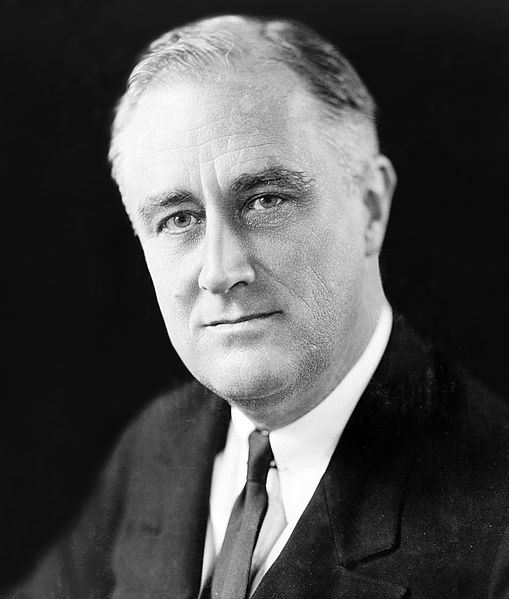
32nd President of the United States
With
the bouncy popular song "Happy Days Are Here Again"
as his campaign theme, FDR defeated incumbent Republican
Herbert Hoover in November 1932, at the depth of the Great
Depression. Energized by his personal victory over polio,
FDR's persistent optimism and activism contributed to
a renewal of the national spirit. Assisted by key aide
Harry Hopkins, he worked closely with British Prime Minister
Winston Churchill and Soviet leader Joseph Stalin in leading
the Allies against Nazi Germany and Japan in World War
II. The war ended the depression and restored prosperity.
In
his first hundred days in office, which began March 4,
1933, Roosevelt spearheaded major legislation and issued
a profusion of executive orders that instituted the New
Deal—a variety of programs designed to produce relief
(government jobs for the unemployed), recovery (economic
growth), and reform (through regulation of Wall Street,
banks and transportation). The economy improved rapidly
from 1933 to 1937, but then relapsed into a deep recession.
The bipartisan Conservative Coalition that formed in 1937
prevented his packing the Supreme Court or passing any
considerable legislation; it abolished many of the relief
programs when unemployment diminished during World War
II. Most of the regulations on business were ended about
1975–1985, except for the regulation of Wall Street
by the Securities and Exchange Commission, which still
exists. Along with several smaller programs, major surviving
programs include the Federal Deposit Insurance Corporation,
which was created in 1933, and Social Security, which
Congress passed in 1935.
As
World War II loomed after 1938, with the Japanese invasion
of China and the aggression of Nazi Germany, FDR gave
strong diplomatic and financial support to China and Great
Britain, while remaining officially neutral. His goal
was to make America the "Arsenal of Democracy"
which would supply munitions to the Allies. In March 1941,
Roosevelt, with Congressional approval, provided Lend-Lease
aid to the countries fighting against Nazi Germany with
England, Scotland, and Wales. With very strong national
support, he made war on Japan and Germany after the Japanese
attack on Pearl Harbor on December 7, 1941, calling it
a "date which will live in infamy". He supervised
the mobilization of the U.S. economy to support the Allied
war effort. As an active military leader, Roosevelt implemented
an overall war strategy on two fronts that ended in the
defeat of the Axis Powers and the development of the world's
first atom bomb. In 1942 Roosevelt ordered the internment
of 100,000 Japanese American civilians. Unemployment dropped
to 2%, relief programs largely ended, and the industrial
economy grew rapidly to new heights as millions of people
moved to new jobs in war centers, and 16 million men and
300,000 women were drafted or volunteered for military
service.
Roosevelt
dominated the American political scene not only during
the twelve years of his presidency, but also for decades
afterward. He orchestrated the realignment of voters that
created the Fifth Party System. FDR's New Deal Coalition
united labor unions, big city machines, white ethnics,
African Americans, and rural white Southerners. He also
influenced the later creation of the United Nations and
Bretton Woods. Roosevelt is consistently rated by scholars
as one of the top three U.S. Presidents, along with Abraham
Lincoln and George Washington.
The
Battle of Los Angeles - February 25, 1942
As
America was gathering its senses after the shocking attack
on Pearl Harbor in December, 1941, there was a heightened
feeling of insecurity and anxiousness. The skies were
being watched as never before as a giant UFO moved through
California, alerting the military and civilian watchers
as well. This case is known as the "Battle of Los
Angeles," and is one of the most important cases
in Ufology.
It
would be early morning on February 2, 1942 when the incoming
craft sirens were first heard in the Los Angeles area.
Many Americans were expecting another wave of Japanese
fighter planes, and thought this is what they would see
as they left their homes, and ventured outside. How wrong
they were! The first sightings of a large UFO would be
made in Culver City, and Santa Monica.
Air
Raid Wardens were ready to go at the first hint of an
invasion. But, this invasion would be something other
than Japanese planes. The giant hovering object was soon
lit up by the gigantic spotlights of the Army's 37th Coast
Artillery Brigade. Everyone who looked up was shocked
by the sight of the giant UFO sitting above their city.
Military aircraft were sent to confront the object.
Because
of a well-organized alert system, the whole California
southern section was searching the night skies in a matter
of minutes. What they saw were beaming searchlights illuminating
the night sky, all of them converging on one thing-a UFO.
A similar scene would be repeated later during the The
Norwood Searchlight Incident albeit, on a smaller scale.
The beams of light would soon be accompanied by tracer
fire from anti-aircraft artillery, all of the rounds aiming
at the invading craft. The giant UFO would take direct
hit after hit, yet without damage.
The
37th Brigade was relentless in its attempt to bring down
the large object, but found no success. The barrage of
spent shells would fall over the entire area-no place
was safe this night. Many were injured, and there were
even reports of death from the falling shells. According
to newspaper reports, eyewitnesses described the sight
of the UFO like a "surreal, hanging, magic lantern."
As
the large UFO moved into more lighted areas, view of the
object became better. It moved directly over the MGM studios
in Culver City. Fortunately, an extremely good quality
photograph was taken of the object-beams attached, tracer
fire visible. This photograph has become a classic UFO
photograph. The UFO would soon move over Long Beach before
disappearing altogether.
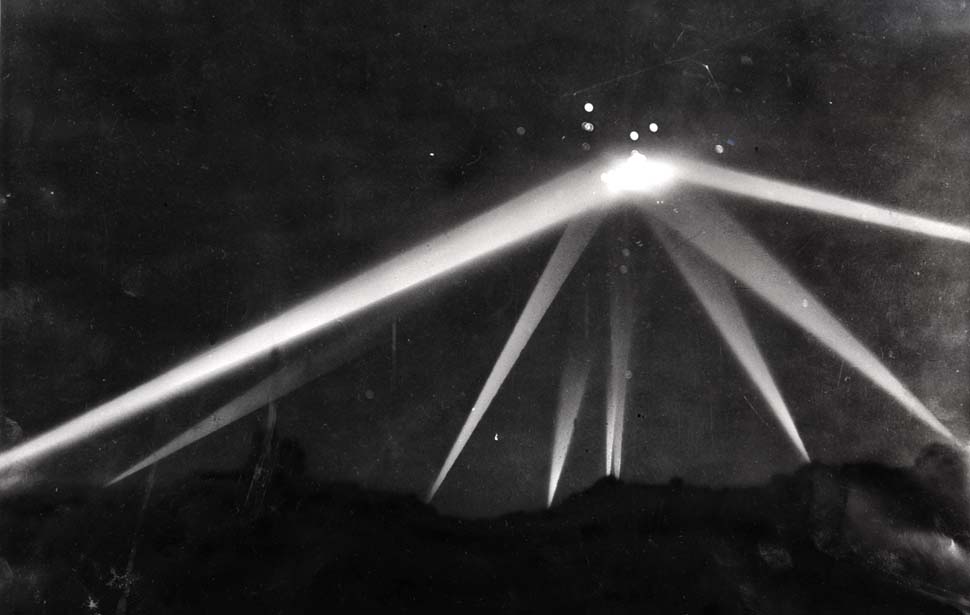
Feb.
25, 1942: Searchlights converge on an unknown object in
the skies over Los Angeles.
During the early morning air-raid alert, more than 1,400
anti-aircraft shells are fired.
General
George Marshall's Secret Memo to President Roosevelt about
the unidentified objects over Los Angeles on February
25, 1942
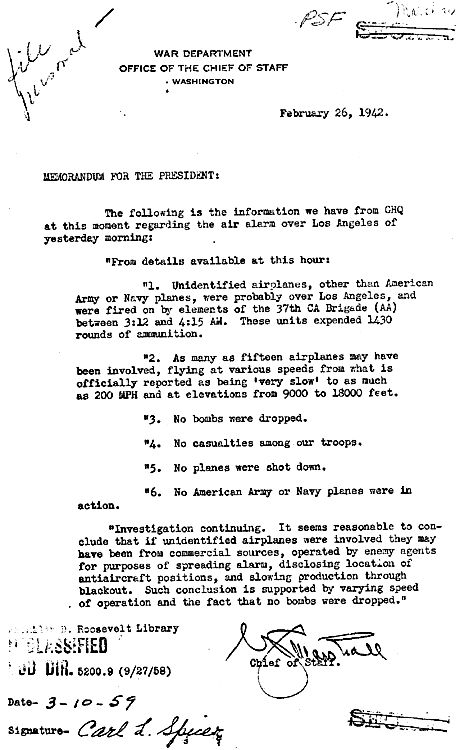
President
Roosevelt writes Secretary of War Harry Stimson concerning
the air raid over Los Angeles on February 25th. The letter
seems to indicate the event was not seen as a UFO event.
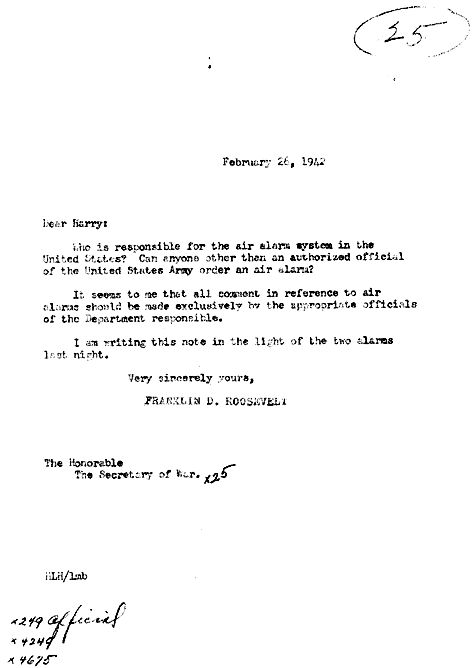
Eleanor's
UFO Interest
There
were a number of UFO sightings that had occurred in March
1950, and at least one appeared to catch Eleanor Roosevelt's
eye. These sighting reports may themselves have been inspired
by the widely read Major Donald Keyhoe article on flying
saucers in TRUE Magazine a month earlier.
The
article it is believed caught Eleanor’s eye was the
following:
"PILOT
MEETS A FLYING DISC -- Veteran Airman Says It was Plenty
Fast"
LITTLE
ROCK, March 21 -- (AP) -- Arkansas' first flying saucer
in nearly three years was reported last night--and by
a veteran airline pilot.
Capt.
Jack Adams of Little Rock, pilot of a Chicago & Southern
Airlines plane en route from memphis, Tenn. to Houston,
Tex., radioed the C & S operations office here that
he had sighted the object near Stuttgart, Ark.
On
landing here a few minutes later, Adams described the
object As circular and "about the size of a DC-3."
At
Houston Adams said: “The object, I'd judge, was about
1000 feet in front and above us. We were headed almost
due west and this object crossed our course from the south.
It was headed due north."
Adams,
who was more than 7000 hours in the air, said the disc
Appeared to be about 100 feet in diameter and was traveling
at a terrific rate of speed--"500 to 600 miles an
hour."
"There
was a bright white light flashing intermittently from
the top of the thing," he said, "and around
the edge were what appeared to be ports, something like
windows in an airplane. There was a light coming from
the ports, but not a bright one."
Adams
said he saw no vapor trail nor any exhaust flame that
might indicate a source of power. It made no noise that
he could hear over the sound of his own engines. "I
have no idea what it was," he said, "but I'm
convinced it was in controlled flight. My guess is that
it's something developed either by the Army or Navy."
Thanks
to UFO historian Barry Greenwood we have an actual 2-page
transcript of the TV show "Today with Mrs. Roosevelt."
The show was on politics but did include a UFO section
on the sighting by Capt. Jack Adams. Adams was a guest
on the show.
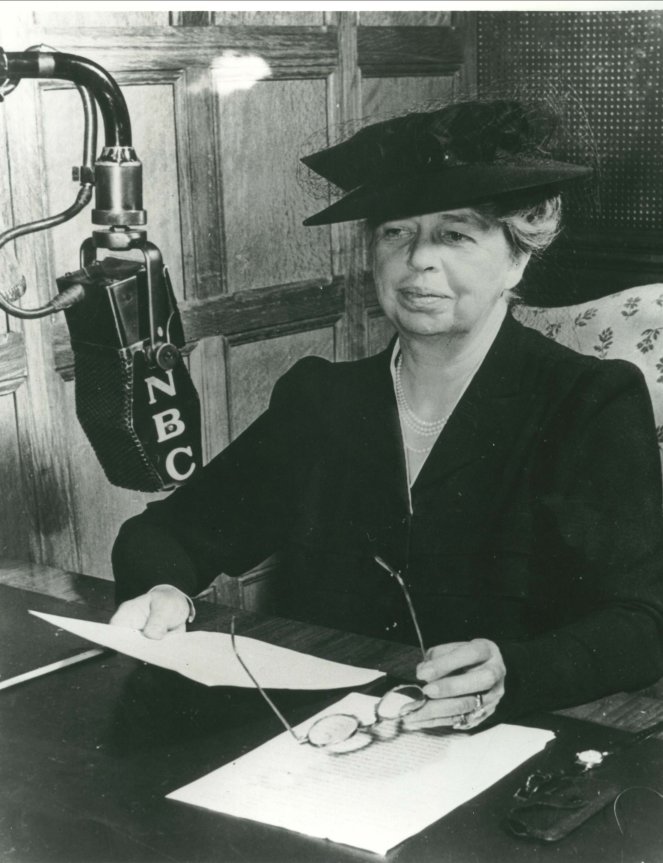
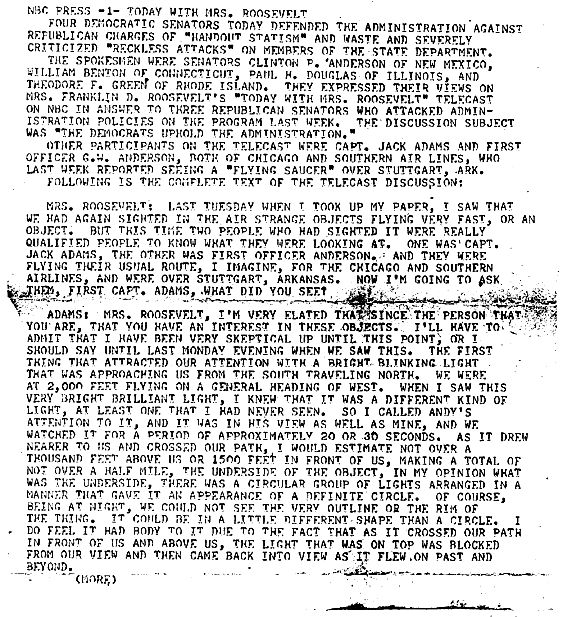
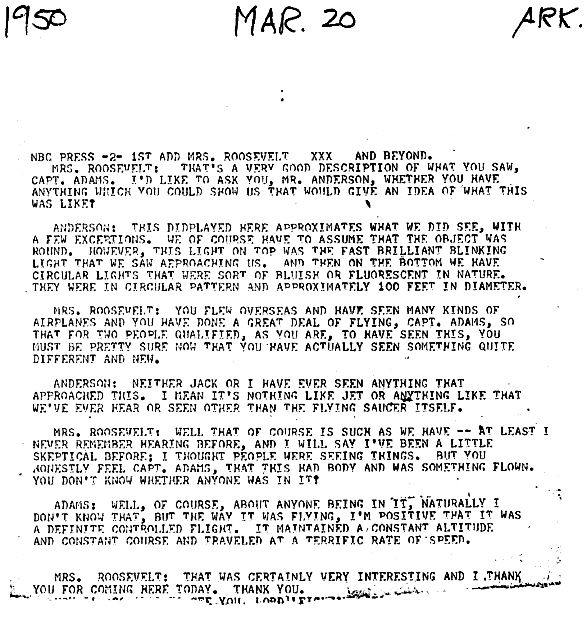
Sources:
http://en.wikipedia.org/wiki/Franklin_D._Roosevelt
http://ufos.about.com/od/bestufocasefiles/p/losangeles1942.htm
http://www.presidentialufo.com/franklin-d-roosevelt
http://www.presidentialufo.com/franklin-d-roosevelt/59-eleanors-ufo-interest
